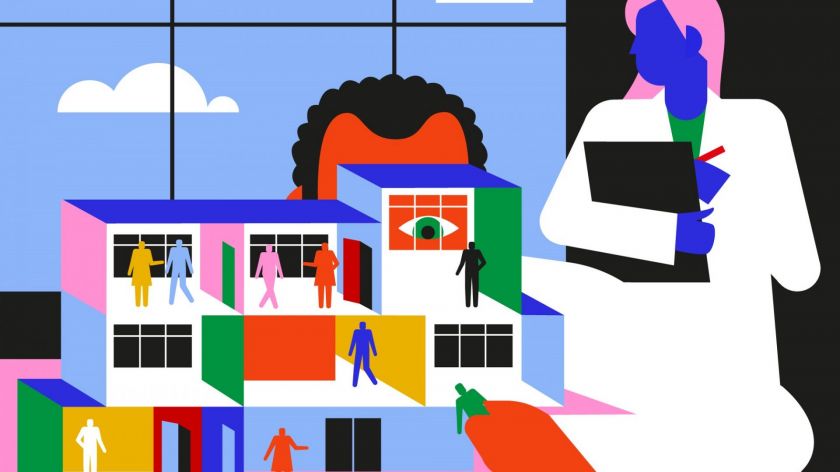-
 Illustratie: Jowan de Haan
Illustratie: Jowan de Haan
Radboud University, as well as other research universities and universities of applied sciences, is doing the utmost to create diverse, inclusive environments. However, monitoring the perception and effectiveness of diversity and inclusion proves difficult in practice. Professor Jojanneke van der Toorn explains why it is essential for good policy.
‘If you don’t know what’s broke, you won’t know what to fix’, says Jojanneke van der Toorn, associate professor of Social and Organisational Psychology at Utrecht University and professor by special appointment of Lesbian, Gay, Bisexual and Transgender Workplace Inclusion at Leiden University. She is also a Research Leader for the Netherlands Inclusivity Monitor, which provides organisations with insight into their diversity policy and inclusivity.
‘The starting point is to pinpoint what you hope to gain by fostering diversity and inclusion. Are you looking to enhance performance, or is there more of a moral motive, such as ensuring equal opportunities for everyone within the demographic options? Both options are possible, but if you want to formulate concrete targets, it’s important to reflect on what your motive is. This will allow you to develop targeted activities and analyse whether what you’re doing is having the desired effect.’
Knowing what you want to achieve
Van der Toorn is seeing a lot of efforts in terms of diversity and inclusion in higher education, but it is often unclear what results the institutions hope to achieve with specific measures, and there is usually no careful monitoring of the effects. For example, there are efforts to increase diversity among staff and students, to make education more inclusive, to ensure that international staff and students feel at home, to provide guidance to first-generation students, to facilitate staff and students with a disability, to encourage women’s career progression and to stamp out prejudice of any kind. These are just some examples. These are all realistic goals, but Van der Toorn points out that many of these measures are not accompanied by clear indications as to what objective they serve or whether the objective is also being met.
‘There’s now more attention for ethnicity, sexual orientation and gender identity’
An investigation at 21 research universities and universities of applied sciences by the higher education media revealed that current hot topics include racism (intentional or unintentional) and gender identity. The emphasis in the not too distant past was more on fostering the emancipation of women and ensuring that international staff and students feel at home. Van der Toorn has realised this as well. ‘We’re seeing a shift. Whereas diversity objectives used to be focused primarily on binary gender and, to a certain extent, nationality, there’s now more attention for ethnicity, sexual orientation and gender identity. Incidentally, these dimensions of diversity are not being recorded within the organisation, which makes it harder to set targets and monitor effectiveness.’
Cultural Diversity Barometer
Van der Toorn highlights the importance of analysing diversity and perceived inclusion within research universities and universities of applied science. This provides insight into what is going on within the organisation and has the capacity to reveal any inequality or differences between groups of staff and students. Anyone engaged in monitoring activities will be able to take targeted measures, taking the specific situation within the organisation into account.
‘It’s important to gain an understanding of support among executive board members, management, staff and students. That doesn’t mean that new policy is only necessary or possible with universal support, but taking opposition seriously will enable you to identify the source of any objections and take these into account.’ Van der Toorn cites the introduction of all-gender toilets as an example. ‘A former student said that some of her female Muslim friends were against the idea of making all toilets all-gender. When she asked what exactly the problem was, the women stated that they were annoyed that they wouldn’t be able to take off their headscarves in an all-gender toilet. Installing mirrors in the toilet cubicles themselves would remedy that.’
If measuring diversity and inclusion is so important for new policy, why is it so difficult to achieve in practice? The diversity survey conducted by higher education media this autumn had to be discontinued after GeenStijl sabotaged it. They deemed it to be an example of higher education institutions forcing diversity down people’s throats.
Back in 2020, there were already issues with the Cultural Diversity Barometer arising from the National Diversity Plan of the then Minister for Culture, Education and Science Ingrid van Engelshoven. This project was to be carried out by Statistics Netherlands (CBS) and was geared towards providing insight into the cultural background of staff in higher education. Five universities had already issued their questionnaires to staff when the project was discontinued. There were doubts surrounding privacy and the way in which people were being pigeonholed in terms of their cultural background. Protests prompted the universities to pull the plug on the project.
Legal and moral obligation
Despite the failures, new attempts are being made to monitor diversity and inclusion policy. The Young Academy wrote a report in September that stated that amassing data on the origins of staff and students is a ‘necessary evil’ in combating discrimination and racism.
One example of this need lies in efforts to attract a greater number of students with a migrant background, which will require knowing how many students there are already and what kind of growth in the demographic might be realistic. However, it is also important to know how students with and without a migrant background perceive the atmosphere in a programme and what kind of issues they encounter. You also need to know how all students, teaching staff and managers view this policy.
This is something that people are struggling with in higher education. That is why the barometer will be relaunched over the coming year. Various research universities and universities of applied sciences, such as Utrecht University, are considering taking part. Statistics Netherlands says it has given proper consideration to specific criticisms.
‘The cultural background goes beyond just the country of origin’
Radboud University is also in favor, a spokesperson said, although some adjustments are needed for a definite ‘yes’. ‘For instance, you could measure the immigration background of employees, but not the cultural background and all sorts of factors that are intertwined. That goes beyond just the country of origin. Think of, for example, spoken language, religious beliefs, socioeconomic status, and nationality, says the spokesperson. ‘In addition, this barometer only offers information on employees. We would also like to have information on students.’
The spokesperson also mentions that Radboud University has the ambition to measure diversity-related data in a biannual staff survey and an annual student survey. ‘We do not measure that data yet, but we want to make that happen within a couple of years. Furthermore, we already have information on employees’ and students’ nationality (and gender). We use this for our diversity policy. However, this is a temporary solution. We support the development of a more cohesive national cultural barometer and are collaborating with Statistics Netherlands (CBS) and other universities to create a method for collecting, sharing, and presenting this data.’
Erasmus University Rotterdam has already committed to participating. Rector Magnificus of EUR Annelien Bredenoord says in Erasmus Magazine: ‘We have a diverse society, and everyone should have an opportunity to flourish and grow, regardless of sex, sexual orientation or cultural background. One way of assessing our inclusiveness would be to examine whether any groups feel they are being prevented from advancing within the organisation, and if so, what obstacles they are facing. As an educational institution, it’s our legal and moral duty to actively work to eliminate discrimination. We’ll be able to do a better job of that if we have the right data at our disposal.’
Privacy legislation
In her own research, Jojanneke van der Toorn has noticed some reluctance on the part of board members and HR departments to amass diversity-related data. ‘They’re quick to point out that certain things aren’t allowed by the GDPR, by privacy legislation. However, there’s a greater degree of flexibility in that legislation than people think, assuming you’re meticulous and ensure you obtain consent. Many people are definitely willing to give their consent, especially if they’re convinced that their employer has their best interests at heart and if they have the sense that the institution will actually act on the insights gleaned to effect improvement within the organisation.’
‘It is important to listen to the group that’s heavily opposed to diversity policy’
Another criticism levelled at the Cultural Barometer pertained to a division into Western and non-Western population groups, which subdivision is not logical or properly substantiated. Van der Toorn: ‘It’s important to reflect properly on the way in which you request information. It would help to involve the people to which it pertains. You also need to be alert to the fact that labels change over time. This sometimes hampers comparison between current data and past data.’
Formulation of questions creates resistance
Formulating questions is a complicated business these days. For example, it is becoming more customary to ask what gender people identify as rather than to ask what sex they are. This can provoke irritated responses, with some respondents stating that they identify as a ‘penguin’ or an ‘Apache attack helicopter’, for instance.
Van der Toorn: ‘Circumspect formulation of questions on identity appears to create resistance. The Apache helicopter is a classic that often crops up in surveys like this. And yet wholesale resistance to diversity policy isn’t widespread. Our survey on support suggests that only around 7 percent of staff are heavily opposed to diversity policy. Moreover, 54 percent of staff support diversity policy, and 40 percent don’t have firm views. A lot could be achieved by providing that group with decent information. It will also be important to listen to the group that’s heavily opposed to diversity policy. Their objections are often the product of fear, such as of no longer being able to get a job as a white male. Once you’re aware of these factors, you can engage with people on these issues and perhaps point out that they won’t be discriminated against and that it’s instead about rectifying an unfair advantage.’
Cultural change
Van der Toorn adds that monitoring policy is not necessarily all about surveys and number crunching. Dialogue with staff and students can also be held through interviews and focus groups and is an inherent part of clear communication with various consultative bodies and participation bodies in higher education. Van der Toorn: ‘These are things that you need to be bold enough to invest in as an organisation. And this has to involve the entire organisation. You need to avoid a situation where diversity policy is something that only diversity officers or specific groups of staff and students focus on. It’s about cultural change within the entire research university or university of applied sciences.’
Justification of the methodology
This article was written by Ries Achterberg and is part of the research on diversity done by the Circle of Editors-in-Chief of Higher Education Media. The study involved an analysis of 36 policy documents from 21 educational institutions: 13 universities and 8 universities of applied sciences*. This relates to visions, strategies, memoranda, action plans and position papers in which educational institutions set out their plans.
As part of this study, we spoke to diversity officers from thirteen universities and seven universities of applied sciences about their work. Nearly all diversity officers cited having to deal with negative responses, three of which said they had received threats. As a result, a number of these individuals were reluctant to participate in this study.
* The participating media of the universities (of applied sciences) are affiliated with the Kring van Hoofdredacteuren Hoger Onderwijs Media (Circle of Editors-in-Chief of Higher Education Media).




